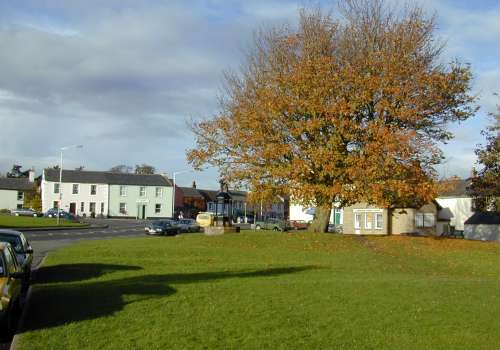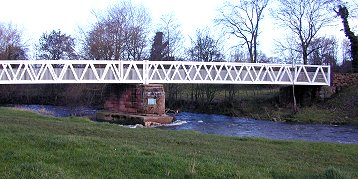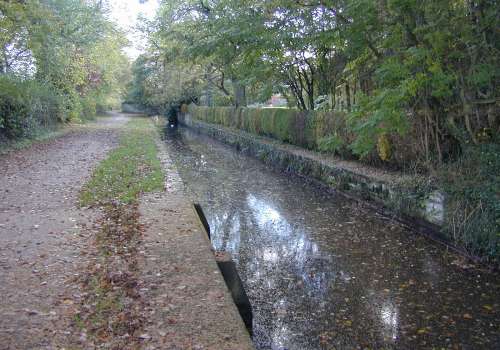
Dalston Square
Updated 5th Feb 2001
Dalston is a small village set in pleasant countryside. The older part of the village extends mainly around the church and village square. In former times, even from as early as the 17th Century, Dalston had water driven mills. By the early 19th century there were several corn mills,four cotton mills and a forge. Of all these only one of the cotton mills remains and now specialises in making cotton wool.
Even today the relatively modern Nestle factory, on the village outskirts, still relies on the River Caldew as a source of it's water requirements. The site of the factory also reflects on the large numbers of dairy farms in the surrounding area. Today we also have an industrial estate again on the outskirts holding a range of businesses.
The Square is the hub of the village with the church, shops, a pub and restaurant, postoffice, hairdressers, library, filling station and cafe. Nearby are the two village schools which add to the bustle of the place.

.
The beauty of Dalston village is that a few minutes walk from the Square and you are in the peace and quiet of open countryside. The following photograph is a view from the "White Bridge" back towards the village, note the millenium sculpture under the chestnut tree. There are a number of walks beginning from the Whitebridge either along the river bank up or downstream or alongside the old millstream and through the cotton wool factory. The Cumbrian Way long distance footpath also passes this point. The chestnut tree was planted on a rather special occasion, for a vivid description with photos click on the following. It Was Some Day

.
The Dalston emblem is a black and red cockerel and the Dalston motto is ' Whilst I live I'll crow' . The following sculpture is a modern representation of the Dalston emblem and was erected in the millenium year. It was placed on the base stones of what was known as the Dalston Lamp, which was a monument erected in 1911 to commemorate the coronation of King George V. For an excellent detailed history of this monument written by Oliver Roberts click on following.. The History of the Lamp

.
The large village green is a feature of the village extending across to the river and the riverside walks. Almost at the end of the Green on the opposite side of the main road is the recreation field which houses a childrens playground, tennis courts and bowling green.

.
The new WhiteBridge at Dalston was erected in 1999 to replace the old bridge which was 100 years old and much in need of major repairs. The new bridge is for pedestrians and horseriders and hopefully it too may reach it's century

.
The riverside at Dalston is particularly scenic because of the lush growth of vegetation along it's banks. It is also an exceptionally good place to see wildlife; kingfishers,dippers,wagtails and herons are often present along with numerous woodland birds.

.
The following photograph shows the view down river to the Stone Bridge taken from the Willow Pool, a good swimming place in Summer. This is about 3/4 of a mile upriver from Dalston Square. There is a nice area of woodland owned by Dalston Parish with some nice woodland walks and also picnic areas laid out. The River Caldew was one of the best trout fishing rivers in England before changes in farming practice caused pollution problems. However there are signs now that it is improving rapidly with some quite good catches of trout reported.

.
A number of years ago fish passes were constructed on several weirs to allow the passage of salmon up the River Caldew. This appears to have been very successful and quite large numbers of salmon can be seen, especially in winter. A good place to view salmon is from the churchyard wall or in the pool above the weir at BridgeEnd. The salmon numbers appear to be at their peak in late December and January. The following photo was taken in mid January 2001 behind Caldew School. It is a large male salmon with a hooked jaw. It measured almost 3 feet long and must have been around the 20lb mark. It has fatally suffered from a fungal disease after it has been weakened from the efforts of breeding. The fungal blotches are quite prominent.

.
The following photo shows a view of one of the old mill streams, the lower part of which is becoming overgrown. However there are some really nice wetland plants in here and it is again a good place to see wildlife. Much of the lower millstream bank is lined with alder trees which are shown on the following photo.However the major feature of the area around Dalston are the large numbers of oak trees, giving the appearance of a heavily wooded area. In reality, almost all of the trees are growing in hedgerows and there are very few woodlands.

On the left, just over the White Bridge, there is a small white gate. After about half an hour the footpath from here leads into Ike's Wood. A round route has been waysigned through this woodland. In the autumn there is a good chance of finding hazelnuts, because many of the understory trees are hazel, as shown in the following photo.

The old mill stream runs alongside the road to the cotton wool factory which is also a public right of way for pedestrians. The waterway provides good living space for the many ducks and also a few trout which can often be seen under the bridge.

.
The ducks will see you coming and often block your route with the expectations of a free meal

.
It is known that Dalston church has existed since 1196 AD because records have been found naming the clergy at this time. it was restored using the local red sandstone in 1750. Bob Roberts has written 'St Michaels Church in Dalston from 1196 to 1961' which provides a wealth of information about both the church and Dalston village. The booklet may still be available in local shops.

.
The churchyard is a haven of peace and tranquility and in the summer there is a wonderful display of wild meadow flowers. The churchyard is managed with conservation objectives. Certain areas of the grassland are left uncut for longer periods in order that the plants can flower and set seed. In the 1960s the churchyard held a high population of slow worms, which are legless lizards, but these haven't been seen for a number of years |
 |
.